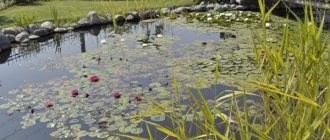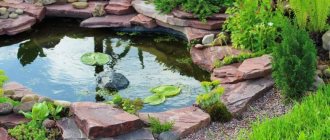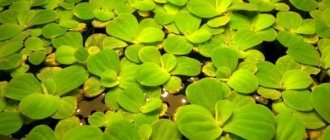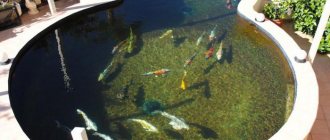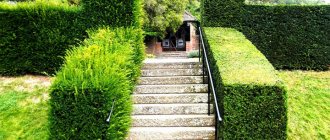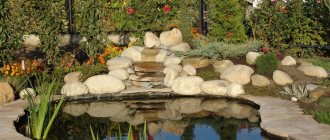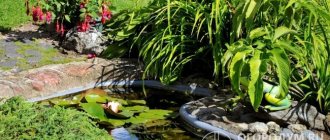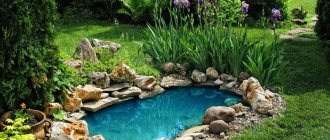We offer you a selection of plants that can be planted in a pond or on the shore of a decorative pond.
Perhaps artificial ponds on the site require extra trouble from their owner, but, you see, there is nothing more peaceful than relaxing at the end of a hard day, sitting in a sun lounger and admiring the water surface of a beautiful pond.
The plants we have listed below will do well close to the water and planted at some depth.
Monetary loosestrife
Perhaps loosestrife is not the most obvious choice for an artificial pond on the site, because in fact it cannot be classified as an aquatic plant. However, this groundcover perennial loves moist areas, so it is perfect for planting along the coast.
Long creeping shoots with round coins of rich green leaves create a pleasant contrast against the background of dark, wet stones. And during flowering, the green “mat” is covered with bright yellow flowers.
Monetary loosestrife is completely unpretentious: you can plant it and virtually forget about its existence! It is frost-resistant and does well near water.
By the way, this plant is edible. In the old days, herbal tea was brewed from it. A natural yellow dye was also obtained from the leaves.
What will take root in shallow waters?
Shallow waters are usually inhabited by moisture-loving plants. Such plants give the pond a complete and bright look and are an important stage in its design.
- Quite often, shallow water is called the element of reeds. And rightfully so it is, because it is difficult to imagine what could better decorate this area. Thickets of reeds will create a personal piece of wild nature near your own home. And the long graceful stems will create the atmosphere of a natural pond.
- Sometimes reeds are confused with cattails, which are also an excellent decoration for an artificial pond. In a small reservoir it is planted in small groups or singly. Easily fits into any design. Its velvety ears usually bloom in July. In general, their flowering period is June-August.
- Another species that contributes to the greening of the reservoir and is located in shallow water is the common calamus or marsh calamus. Its distinctive feature is the sharpness and severity of its lines. Highlights the focal point of the pond and accentuates the details.
- Suitable for planting in shallow water and iris. It will complement the decor of a country pond with bright colors, rich greenery, and yellow flowers will add sunshine and mood.
- Marigold is considered the most unpretentious crop. It blooms already in April. It resembles a buttercup flower, and the leaves are heart-shaped. Marigold is ideal for small bodies of water.
All these seed plants are suitable for both planting in shallow water and marshy areas, so they can be fully considered not only coastal, but also marshy.
Kubyshka
Capsule is a nice aquatic plant that not only decorates, but also cleanses the pond. If you are afraid that the water in your pond will bloom, plant a capsule there and consider that the problem is solved.
Like many unpretentious plants, it grows quite quickly. Therefore, thickets of egg capsules need to be regularly thinned without sparing.
You will learn more about growing this plant in our article.
- Yellow egg capsule - is it difficult to grow in a pond?
What is the care of the egg capsule and how to propagate it.
Plants around the pond
In order for the pond to fit organically into its surroundings, the usual deciduous trees and shrubs, conifers, herbs and flowers are planted around it. Typically, trees are placed away from the water surface, flowers and herbs are planted at the water's edge, and bushes are planted in between. This is done for two reasons: the pond remains open for admiring, and falling leaves do not clog the water. Among the pond plants planted in the coastal zone are the following species:
- Caragana tree (yellow or Siberian acacia) . Deciduous shrub with lacy foliage and small yellow flowers of the moth type. The bush is undemanding to soil quality and tolerates frost well.
Siberian acacia Source 1d.ru
- Shaggy plum Pendula . Weeping, slow-growing tree; Blooms profusely pink before the leaves emerge.
Shaggy plum Source sadrium.ru
- European larch . Standard varieties with a weeping crown (Puli, Kornik). A small tree with soft needles that fall off in winter, it is frost-resistant, but needs sun and loves fertile soil.
European larch Source romashkino.ru
Water lilies
Water lilies, or nymphs, are classic aquatic plants. Many gardeners decide to set up an artificial pond on their property just to have water lilies on their property.
These flowers delight with a variety of inflorescence color options: among them there are white, yellow, pink, orange, green, and even blue and purple.
- Nymphea - the best varieties with photos, planting and care
Everything you wanted to know about growing water lilies.
Winter-hardy types of nymphs include white water lily, tetrahedral water lily, fragrant water lily, pure white water lily, and knobby water lily.
Practical benefits of plants for a pond
It doesn’t matter what size the country pond is. A mini-pond will decorate a small garden; on a larger plot, a man-made lake will look picturesque. To design the water surface and shores, you will need natural materials: sand, stones, pebbles. But in order to give an artificial reservoir the most natural look possible, you cannot do without aquatic and coastal plants.
A deserted water mirror surrounded by the same shore looks boring. Aquatic plants for a pond are not only an opportunity to show your imagination and turn a plastic container dug into the ground into a pearl of the garden. The decorative purpose is important, but if you choose the right flora, you can also solve important practical problems:
- Saturate the water with oxygen, create a habitat suitable for aquatic fauna (fish, snails).
With an emphasis on cereals Source yandex.net
- Maintain the ecosystem by preventing mud from growing and helping the water stay clean.
- Protect the water column from excessive penetration of ultraviolet radiation.
Therefore, pond plants are conventionally divided into two groups: ornamental crops and health plants. The former are distinguished by their spectacular appearance, large floating leaves and bright flowers. These include water hyacinths, lilies, and lotuses. The latter are not so impressive, but without them it is impossible to maintain the health of the reservoir. The water remains clear thanks to swampweed, hornwort, and elodea.
With a waterfall Source diz-cafe.com
Pistia
Pistia is often colloquially called water lettuce. It can decorate any pond thanks to its rosettes of lime-colored leaves. It really does look like floating heads of lettuce!
Despite the fact that pistia is a beautiful plant, it needs an eye and an eye! It grows rapidly, actively absorbing water from the reservoir, resulting in waterlogging. Of course, only if you don’t tame her in time.
Chinese farmers grow pistia in fish ponds as pig feed. Therefore, this lack of pistia also has a beneficial side. If you have a small farm, it is quite possible to feed excess water lettuce to animals.
Basic landing rules
- It is recommended to plant plants in ponds after the pond has been filled with water and has settled for at least 10-14 days. The optimal time of year is late spring, early summer. Depending on which variety is chosen, they are planted at the bottom of the reservoir or along the shore. And don’t forget about the rule that each sprout must be placed in a flower pot.
- Why are holes needed in baskets? A small addition. Each pot should have holes in the bottom and walls for good ventilation. Otherwise, the roots will begin to rot. By the way, caring for such plants will be much easier. For the winter, you can move them to a warm room.
- What soil to use for landscaping a pond with plants? It could be soil mixed with clay or bone meal. It is better to immediately forget about fertilizers such as manure, black soil and peat. They can provoke poisoning of fish, frogs and other inhabitants of the reservoir.
- How to avoid soil being washed out of pots? After planting, a coarse fabric (for example, burlap) is laid on top and sprinkled with small pebbles.
- How to prepare plants for planting? Regardless of which type was chosen, it is recommended to remove old and yellowed leaves, as well as long roots.
- How to survive the winter? In summer, the plants will begin to grow abundantly, so they need to be thinned out from time to time. Old shoots are removed. Aquatic crops that are accustomed to a temperate climate can be left in the pond of a summer cottage for the winter.
As for exotic plants, it is better to remove them from the pond for the winter and place them in an aquarium or bathtub. It is advisable to provide additional lighting.
- Can you get plants from a local pond? Rather yes than no. This option is suitable for summer residents who cannot yet afford to buy exotic flora in the store. Carefully study what exactly grows and at what depth. After this, select individual species for your pond. First, stock up on poles that will help you probe the soil, as well as rubber boots with boots of a decent height.
Pontederia
Pontederia is a very beautiful plant that will decorate your garden with shiny heart-shaped leaves, and in late summer with beautiful panicles of inflorescences in white, lavender, and blue shades.
The great advantage of this decorative perennial is that it is an excellent natural filter and is able to purify water and soil.
Pontederia is planted at a depth of 5-10 cm below the surface of the water. In mild climates it winters well without any shelter, but in the middle zone it will most likely freeze out.
Gardeners combat the low winter hardiness of this crop in the following way: they plant pontederia in large container-baskets that do not restrict the horizontal rhizome, place them in water, and with the onset of cold weather, take them out and store them together with other delicate aquatic plants.
An alternative option is to grow pontederia in deep ponds and, with the onset of autumn, move the basket to a depth of at least 1-2 m, where the water will not freeze.
Briefly about the main thing
A pond in the garden is not only water and stones; Plants become an important decorative detail. They help to fit an artificial reservoir into the landscape and perform other functions: they purify the water, protect it from sunlight and saturate it with oxygen.
Plants are planted in zones, taking into account their characteristics. Oxygenating plants are natural purifiers; they are entirely hidden in the water column. Floating species make the surface of the pond picturesque; hydratophytes with their large and bright flowers become the highlight of the landscape. Plants in the coastal zone should be selected especially carefully, taking into account their size and moisture-loving properties.
Ratings 0
Horsetail
Horsetail (swamp, riverside, wintering) is a real find for landscaping ornamental ponds! Its main advantage is its bamboo-like stems, which will surround the pond with a spectacular green fence.
They plant it on the shore of a reservoir, but it is not afraid of going a little deeper into the water - in it the horsetail feels like it is in its element.
As popular wisdom says, beauty requires sacrifice. And this is true in landscape design too! Horsetail is decorative, but can act like a real invasive species: at the end of summer, cut the stems back to the ground to prevent the spread of spores. And don’t be afraid to thin out your plantings.
Can you boast of having a decorative pond on your site? Share your photos with us in the comments to this article!
Factors influencing choice
Choosing plants for a summer cottage pond is an interesting and quite difficult task. Finding which plants will be appropriate and adequate in an existing body of water is not easy. The choice of required plants is influenced by various factors. The purpose of the pond itself will determine what plants should be planted there. It is logical that different plants will be needed for fishing and decorative ponds.
Another factor that influences this is the allocation of one side of the pond as a recreation area. The overall design should be organically combined with the selected plants and the owner’s ideas. Therefore, along the shore where you plan to spend time, it is recommended to plant low, herbaceous plants that will not block the view of the pond and the access to it.
Aquatic flowers: marsh flower
The root of the mireweed is at the bottom of the reservoir, and the leaves and flowers are held above the water. The plant is attached to the soil at the bottom by a creeping rhizome, so it is classified as a hydrophyte.
External features of the plant:
- round leaf plates with a small heart-shaped cutout at the base of the leaf;
- the bright green base of the leaf has a brown edging along the edges;
- stems grow from the rhizome, on which yellow flowers appear.
September
, cleansing the reservoir of pollution and surface film. In an artificial pond, you need to make sure that the flower on the water is in the sun, otherwise the petals quickly disintegrate and wither.
To propagate marshwort, shoots are cut off and placed in a container with water and a layer of sand at the bottom. In winter, the plant is stored in the cellar, planted in a pot. The container is immersed in water so that the roots of the plant do not dry out.
Floating
The root of floating species has no connection with the soil, and the leaves and flowers float on the surface of the water. If left unchecked, they quickly fill the entire surface. Like oxygenators, they prevent water from blooming and overheating in hot weather.
Related article:
Cuttings of roses - a simple way of vegetative propagation
Azolla
Tiny (width 1 cm), similar to openwork moss, ferns (A. carolina, A. fern) are used to landscape small light or slightly shaded ponds. They are heat-loving, so for the winter they are placed in a container filled with moist soil and kept indoors until spring. The stem is branched, covered with small leaves, light green in summer and turning red in autumn. The mat floating on the surface grows quickly, but in a small body of water it is easy to catch with a net.
Common watercolor or frogweed (Hydrocharis morsus-ranae)
H. morsus-ranae is used to decorate small and large ponds, since it is winter-hardy and grows in partial shade and in the sun. The leaves are round, heart-shaped at the base, up to 5 cm in diameter, similar to the leaves of a water lily. Above them, at a height of 3-5 cm, small delicate beautiful flowers with white petals, bright yellow pistils and stamens form. The flowering period lasts all summer.
The stem is shortened, fleshy roots and lateral shoots with rosettes of young plants extend from it. In the fall, thin shoots with buds appear, which, having fallen off, overwinter at the bottom, and in the spring, thanks to the air cavities formed on them, they emerge and the life cycle repeats. Can be propagated by dividing shoots.
Eichornia or water hyacinth (Eichhornia crassipes)
Water hyacinth is easily recognizable - its leaves are large (diameter up to 18 cm), smooth, curved, similar to an inverted wide spoon, 4-8 pieces are collected in a rosette. Long (up to 2 m) shoots and a thick fleshy root are kept floating thanks to the porous base of the leaf. At great depths, the flower floats, and where it is shallow, it takes root in the bottom sediments.
In August, soft pink, purple, and various shades of lilac flowers bloom, similar to hyacinth. Their lifespan is short - only a day, but if there are many flower stalks, then the flowering is long. The seeds are formed in a capsule and, when ripe, are thrown into the water. They do not survive in temperate climates, so new seeds are planted in the spring. For the winter, Eichornia can be placed in a jar or aquarium.
Related article:
Persicaria for your garden: types, description and secrets of growing
Without proper control, hyacinth quickly grows, covering the surface of the reservoir with a dense “carpet” that blocks the access of oxygen. If you do not thin out, other pond flowers and fish may die without getting air.
Common reed (Phragmites communis, syn. P. australis)
Common reed.
Photo from econet.ru The reed has long, erect, bluish-green straw stems up to 3-4 m high. The flowers in brown-violet spikelets-panicles are small, inconspicuous, bloom from July to autumn. In August-September they turn into attractive attention silvery-brown fluffy plumes. There is a decorative variety of reed 'Variegata' - up to 1 m high, leaves with golden yellow, later white border
Features of cultivation
Variegata
The Latin name of the reed - Phragmites - comes from the Greek word phragma
, which means
fence, fence
. And this is no coincidence, since since ancient times it has been used to cover roofs, build fences, and weave baskets.
Oxygenators
Oxygenators are plants that extract carbon dioxide dissolved in water and release oxygen back. For natural and artificial decorative ponds they are necessary - without them the water will bloom. Such greenery is also necessary for fish, as it serves as food and shelter for them during spawning.
To plant oxygenators, special plastic containers are used, and so that they are not noticeable in clear water, they are masked with pebbles, stones, and soil. Many varieties do not tolerate the central climate very well, so it is recommended to plant two or three species at the same time.
Interesting information: Surface of water for decorating the site: 5 types of reservoirs in the country
Swamp butterfly (Hottonia palustris)
The difference between turchi and other oxygenators is its bright flowering. Flowers with white or light purple petals bloom on low (up to 25 cm) peduncles in May-July. The leaf blades are pinnate, bright green, and die off in the fall. Overwintering occurs in the bottom part in the form of resting buds. Propagated using cuttings and leaves.
Among the non-flowering decorative oxygenators we can distinguish swampweed, water moss, floating pondweed, and elodea.
